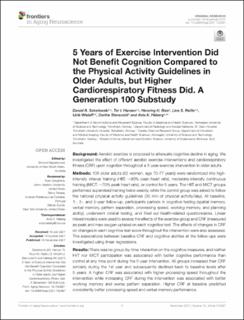| dc.description.abstract | Background: Aerobic exercise is proposed to attenuate cognitive decline in aging. We investigated the effect of different aerobic exercise interventions and cardiorespiratory fitness (CRF) upon cognition throughout a 5-year exercise intervention in older adults.
Methods: 106 older adults (52 women, age 70-77 years) were randomized into high-intensity interval training (HIIT; ∼90% peak heart rate), moderate-intensity continuous training (MICT; ∼70% peak heart rate), or control for 5 years. The HIIT and MICT groups performed supervised training twice weekly, while the control group was asked to follow the national physical activity guidelines (30 min of physical activity/day). At baseline, 1-, 3-, and 5-year follow-up, participants partook in cognitive testing (spatial memory, verbal memory, pattern separation, processing speed, working memory, and planning ability), underwent clinical testing, and filled out health-related questionnaires. Linear mixed models were used to assess the effects of the exercise group and CRF (measured as peak and max oxygen uptake) on each cognitive test. The effects of changes in CRF on changes in each cognitive test score throughout the intervention were also assessed. The associations between baseline CRF and cognitive abilities at the follow-ups were investigated using linear regressions.
Results: There was no group-by-time interaction on the cognitive measures, and neither HIIT nor MICT participation was associated with better cognitive performance than control at any time point during the 5-year intervention. All groups increased their CRF similarly during the 1st year and subsequently declined back to baseline levels after 5 years. A higher CRF was associated with higher processing speed throughout the intervention while increasing CRF during the intervention was associated with better working memory and worse pattern separation. Higher CRF at baseline predicted consistently better processing speed and verbal memory performance.
Conclusion: In this first 5-year randomized controlled trial investigating the effects of HIIT, MICT, and physical activity according to national guidelines on cognition, we observed no effect of exercise intervention group on cognition when compared to following the national physical activity guidelines. Still, the results showed that higher CRF and increasing CRF benefited multiple, but not all, cognitive abilities in older adults. | en_US |

